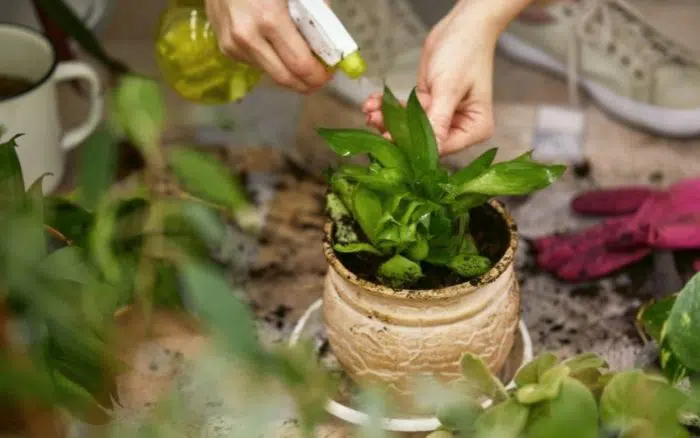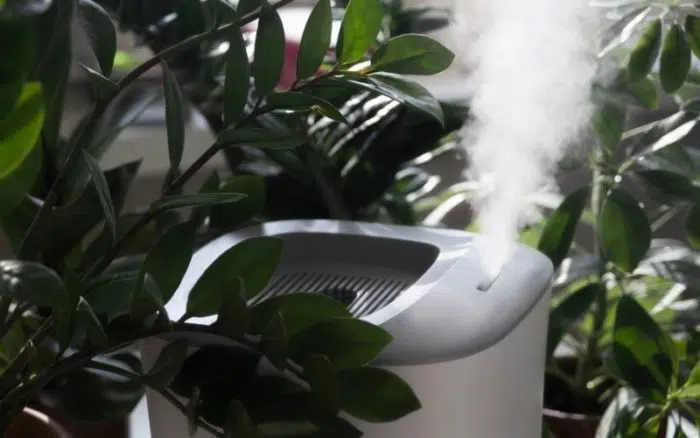Grow tents provide an ideal environment for plants, but in order to create a healthy growing space, it is important to maintain a proper humidity level. Too much humidity can lead to mold and mildew, while too little can stunt plant growth and cause lower yields.
Humidity levels are often best between 40-75% for most plants. If your humidity is low, you want to act fast to save your plants.
Ideal Humidity & Temperature for Growing Stages
When growing in a grow tent or grow room, you want to make sure you’re keeping track of the temperature and relative humidity at all times.
You can easily track these numbers with a digital hygrometer like this. Using a hygrometer like this you can check in on your grow tent from anywhere with the app, and get notifications if humidity gets too high or drops too low.
| Stage | Temperature (F) | Temperature (C) | Relative Humidity |
| Seedlings & Clones | 75-78 | 23-25 | 70-75% |
| Veg | 70-83 | 21-28 | 55-70% |
| Flowering | 65-80 | 18-26 | 40-55% |
| Harvesting | 65-75 | 18-24 | 35-40% |
| Drying | 65-75 | 18-24 | 45-55% |
How to Raise Humidity in Grow Tent
There are a number of ways you can raise the humidity in your grow tent. Raising humidity in your grow tent can be done by using a humidifier, hanging wet towels, and even reducing the air temperature surrounding the grow tent. Each has its place and can be used in different situations. Let’s walk through each one.
1. Place a Bowl of Water in the Tent
Another way to raise the humidity level is to place a bowl of water on the floor of the grow tent. As the water evaporates, it will help to increase the overall level of humidity.
If your tent is small and doesn’t have a fan on the floor, try and place the water up a little higher towards where the air flow is happening. If you have a shelf in your grow room, this is a great option.
Place the bowl or tray near the air intake tubing and passive air holes if possible.
When to Use It:
- For a more gradual, consistent way of increasing humidity
2. Place Wet Sponges on the Floor
Similar to the wet towel methods, you can leave wet sponges on the floor of the grow tent which will quickly increase humidity. Because a sponge is going to dry out faster than a bowl of water will, the humidity will increase faster than that method.
When to Use It:
- You need to increase your humidity FAST
- Great for small grow tents
2B: Add Wet Sponges to the Bowl of Water
This method combines the last two in a way that makes sure you don’t have to constantly replace the dried out sponges constantly.
Because sponges dry faster, they will release the water in the bowl at a faster clip than the bowl would by itself. So if you’re looking for a way to increase humidity faster, this is a great otion.
When to Use It:
- You want to increase the humidity in grow tent fast, but not constantly watch the sponges for drying out.

3. Mist Your Plants
Misting your plants with a spray bottle is an easy way to get moisture into the grow tent quickly. This method is best for seedlings, cuttings, and younger plants, as mature plants absorb moisture from roots.
You’ll want to spray water on both the top and underside of the leaves. It’s best to use this method in the morning so the leaves have enough time to dry out throughout the day without increasing the chance of disease or pests setting in.
You don’t need fancy spray bottles, this $15 one works great for me.
When to Use it
- You just want a small boost of humidity
- You need a quick way to increase humidity, but know this isn’t a long-term solution
4. Grow Mature and Young Plants Together
If you’re growing smaller plants and seedlings, you can add some larger plants into the mix as they will release more moisture.
Generally, the larger the plant, the more water it needs and the more moisture it will release. That moisture being released by the older plants will increase the grow tent humidity.
Younger plants also take more moisture from the air, whereas more mature plants get their water from the roots.
5. Hang Wet Towels
You can also hang wet towels around your grow tent to raise humidity levels in the tent. The water will evaporate into the air, increasing the humidity in the tent.
6. Use a Garden Cloche
If you have tried other methods and just can’t get the humidity to stay consistent, you might want to try a garden cloche.
A cloche is similar to a humidity dome for seedlings, where you’re using the plastic to keep the humidity in for a while. Humidity domes, aka cloches, are great for a short amount of time, but you need to watch them closely because if they aren’t vented properly, you can be looking at mold issues.
7. Set Extraction Fan to Minimum Setting
Decreasing the extraction fan speed will allow more humidity to stay inside the tent until you can raise the humidity enough. Of course, the extraction fan is necessary and we need fresh air and good airflow in the tent, but air flow does lower humidity.
When to Use It
- Lowering the settings on the extraction fan is a good way to temporarily reduce the amount of humidity escaping the tent.
8. Lower the Temperature Surrounding the Tent
Humidity is relative to temperature, the warmer the air, the more water vapor the air will hold. Having a lower temperature around the tent is going to help increase humidity automatically.
When you lower the air temperature, the colder air will fall to the floor of the tent and the hotter moist air will rise towards the top of the tent. This process will increase the humidity.
9. Air Conditioner for a Grow Tent or Water Chiller
You can lower the temperature by adding an air conditioner or water chiller inside the tent if yours doesn’t have a temperature controller.

10. Grow Tent Humidifier
Of course, the easiest way to increase the humidity is with a grow tent humidifier, so it had to be included here. This will add moisture to the air, helping to create a more hospitable environment for your plants.
A humidifier will automatically monitor the water supply and temperature to release water in the air and keep the humidity level consistent.
This is by far the easiest method for creating a humid environment, but is also the most pricey. But plants need different humidity levels depending on their growth stage (flowering plants vs veg stage), so a humidifier makes it easy to switch it up quickly.
When to Use It:
- If you want a more long-term solution that is mostly automated
- You need a consistent option to increase yields
While it makes life easier, you don’t need a humidifier to increase the humidifier in your grow tent. Here are some ways to make a “DIY” humidifier for your grow tent.
11. Use a Humidity Controller
With a humidity controller, you can fully automate the humidifier and humidity levels in your tent. You can go as budget or as advanced as you want as there are tons of options for controllers.
Some will send you notifications if the humidity and/or temperature gets out of whack, while others are more manual and need to be checked regularly.
Signs Your Humidity is Too Low or High (Symptoms of High and Low Humidity)
It’s best to have a hygrometer in the grow room or tent that is on all the time, letting you properly track humidity. However, there are some other signs and symptoms that your tent needs a higher relative humidity.
Low humidity symptoms in plants are:
- Signs of disease
- Fungal pathogens
- Shriveling and leaf curl
- Wilting leaves
High humidity symptoms in plants are:
- Slow plant growth
- Mildew and mold
- Fungal growth
- Root and bud rot
How to Lower Humidity in the Tent
High humidity in a grow tent is quite rare since plants act as their own humidifiers as they are always losing water, especially when the grow lights are turned on.
Some ways to lower humidity in a grow tent are:
- Avoid overwatering your plants
- Place a dehumidifier in the tent
- Remove any stagnant water (i.e. in trays or bowls)
- Increase the fan speed
- Turn on your grow lights
- Add more fans in the tent to keep proper ventilation
What is Humidity?
Humidity is the amount of water vapor in the air. Water vapor is the gaseous state of water and is invisible. However, when air becomes saturated with water vapor, tiny droplets of water form and we see this as fog, mist, or clouds.
The amount of water vapor that air can hold depends on its temperature. Warm air can hold more moisture than cold air.
Humidity can be measured in 3 ways:
- Relative humidity – the most important one to watch for indoor growers
- Absolute humidity – the mass of water
- Specific humidity
Relative humidity is the one most indoor growers care about because it impacts the plants the most.
Luckily, there are ways to measure humidity so you can adjust your indoor environment accordingly. A hygrometer measures humidity levels in both warm and cold climates and can be used to monitor conditions in your grow tent.
Keeping the humidity inside your tent at the right level is so important for the proper growth of plants in a confined space.


